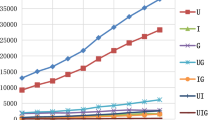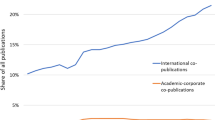Abstract
Co-authored publications across sectors have been used as indicators of the triple helix model and more generally for the study of science–technology relations. However, how to measure the relationships among the three or more sectors is a technically difficult issue. Using mutual information as an indicator has proved to be effective, but it is not widely used. In this paper, we introduced φ coefficients and partial correlation as conventional indicators to measure the relationships among sectors on the basis of Japanese publication data in the ISI-databases. We also proposed a new approach of graphical modeling based on partial correlation for studying university–industry–government relationships and relationships with other sectors. The conventional indicators give results that are consistent with mutual information, which shows that collaborations among the three national sectors (U, I, G) are getting weaker and that members of these sectors tend to collaborate much more with foreign researchers. It is also shown that universities used to play the central role in the national publication system and acted as a bridge between national sectors and foreign researchers. However, since 2000, the situation has been changing. The center of the Japanese research network is becoming more “foreign” oriented.






Similar content being viewed by others
References
Cover, T. M., & Thomas, J. A. (1991). Elements of information theory. New York: Wiley-Interscience.
Dempster, A. P. (1972). Covariance selection. Biometrics, 28, 157–175.
Edwards, D. (2000). Introduction to graphical modeling (2nd ed.). New York: Springer.
Etzkowitz, H., & Leydesdorff, L. (2000). The dynamics of innovation: From national systems and ‘mode 2’ to a triple helix of university–industry–government relations. Research Policy, 29(2), 109–123.
Fano, R. M. (1961). Transmission of information: A statistical theory of communications. Cambridge, MA: MIT Press.
Gibbons, M., Limoges, C., Nowotny, H., Schwartzman, S., Scott, P., & Trow, M. (1994). The new production of knowledge: The dynamics of science and research in contemporary societies. London: Sage.
Hirono, M. (2003). G-GM & L-GM systems for graphical modelling. Bulletin of the Computational Statistics of Japan, 15(1), 63–74.
Iwahara, S. (1982). Inferential statistics for education and psychology (3rd ed.). Tokyo: Nihon Bunka Kagakusha.
Leydesdorff, L. (2003). The mutual information of university–industry–government relations: An indicator of the triple helix dynamics. Scientometrics, 58(2), 445–467.
Leydesdorff, L., & Sun, Y. (2009). National and international dimensions of the triple helix in Japan: University–industry–government versus international co-authorship relations. Journal of the American Society for Information Science and Technology, 60(4), 778–788.
Miyakawa, M. (2003). Graphical modeling. Tokyo: Asakura Shoten.
Narin, F., Hamilton, K. S., & Olivastro, D. (1997). The increasing link between U.S. technology and public science. Research Policy, 26(3), 317–330.
Sun, Y., Negishi, M., & Leydesdorff, L. (2007a). National and international dimensions of the triple helix in Japan: university–industry–government and international co-authorship relations. In: the 11th international conference of the International Society for Scientometrics and Informetrics (ISSI2007), Madrid, Spain, pp. 936–937.
Sun, Y., Negishi, M., & Nisizawa, M. (2007b). Co-authorship linkages between universities and industry in Japan. Research Evaluation, 16(4), 299–309.
Author information
Authors and Affiliations
Corresponding author
Rights and permissions
About this article
Cite this article
Sun, Y., Negishi, M. Measuring the relationships among university, industry and other sectors in Japan’s national innovation system: a comparison of new approaches with mutual information indicators. Scientometrics 82, 677–685 (2010). https://doi.org/10.1007/s11192-010-0179-7
Received:
Published:
Issue Date:
DOI: https://doi.org/10.1007/s11192-010-0179-7




